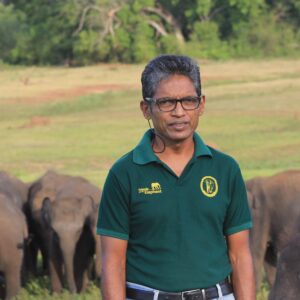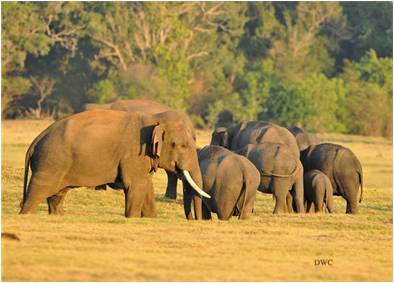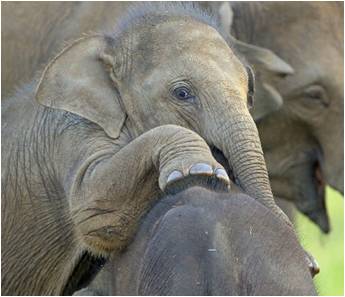Episode 5 – Minneriya National Park

An experience of life and death
One day when I was at the Wilgamuwa office I received a message saying that an injured elephant was in the Minneriya area. I went to treat it with two assistants Gamunu and Jeewaka. The jungle around the Minneriya tank was an elephant habitat.
The Minneriya tank dam was destroyed a couple of hundred years ago but recently renovated. There are therefore thousands of mature trees submerged in the water, but as the level drops in the dry season, those dead trees gradually begin to emerge. They provide a wonderful opportunity for a perching and nesting site for thousands of birds that rely on a fishy diet. As the water level in the tank recedes, lush grasslands appear which are capable of feeding hundreds of elephants, These green pastures, stretching for thousands of acres with the exposed dead trees reaching skywards crowded with flocks of birds and the elephants grazing below, create a grand spectacle.
On the day that we visited the area we saw elephants by the hundreds feeding there. As we drove the vehicle all over the place searching for the injured one, we eventually spotted a huge elephant at the corner of the tank. From its behavior and the information received, we suspected it to be the one we were looking for. Getting closer to it, we observed it splashing mud on a wound on the right lateral side of it’s belly. It was such a huge wound it made us wonder how it could possibly have happened. The elephant was definitely suffering, as the wound had festered and the flies were attacking it. In addition, a gunshot injury could be seen on the left front leg above the knee. This too had festered, though it was not so serious. Another thing we noticed was that it was blind in one eye.
I decided to tranquilize and treat it. Driving a short distance away, we prepared our equipment. In the meantime, the elephant had come on to the dry area of the grassland, leaving the water’s edge behind it. Although we had wanted to dart it and have it drop within the grassland, the elephant had walked out to the edge of the tank and we could not reach it in the vehicle. It was going to be a risky job for us to get to it on foot particularly as we had no skilled assistants. I planned to make use of its blind eye and use it to my advantage so, leaving the vehicle, we crept up to it on its blind side to prepare for darting.
Jeewaka followed me with a shotgun. Crawling forward, we slowly approached the elephant. About 50 yards away, I targeted correctly and the dart struck its mark. It became agitated and turned towards us but did not see us as we were stretched out on the ground. Sensing it was in danger it started running towards the jungle. We ran back to the vehicle and drove towards the elephant to block its way. Our attempts to stop it failed as it was running among other elephants entering the jungle, placing us in a very dangerous situation. It was a fairly thick patch of jungle with elephant tracks crisscrossing everywhere, making it extremely difficult to follow one particular set of footprints. Carrying our equipment, we started on a dangerous mission. To have only three people in the team is nowhere near sufficient for such an operation and, in addition, the other two were novices facing such a situation for the first time.
Safety was most important, as elephants were everywhere and we were following a potentially dangerous one that was agitated and knew it was being followed. Fortunately, after walking for about 100 metres into the jungle we were able to recognize the tracks of the sedated elephant. There appeared to be a dragging effect in the footprints, which was a positive sign that the tranquilizer had started working. Expecting to see the unconscious elephant, we carried on. Fortunately for us, it had fallen on the path without any hindrance to its normal breathing.
Straightaway we managed to clean some of the wounds and inject all necessary antibiotics and other supportive medicines. We could not properly clean the wound at the right lateral abdomen as the animal had fallen on that side. However, we knew that our medicine would help it to get rid of maggots and irritation while enhancing the healing process. I took a photo of my two assistants standing beside the unconscious elephant as it was their first experience of tranquilizing such an animal. After administering the recovery injection, we watched it from a safe distance but were worried because it was not getting up even though we poked it with a branch. After a while, it began to show signs of recovery so we moved further away for our own safety. However, it did not stand up but was resting on its chest. The posture of sternal recumbence is not recommended for elephants, as it can lead to respiratory complications which in turn could lead to suffocation. I wanted to make it stand upright.
Under such circumstances, the normal procedure is to light some crackers to frighten it into getting up but this was not possible as other elephants feeding in the grassland would rush into the jungle in chaos. It was now nearly 6 p.m. and was getting dark. Making a noise, foot by foot we approached our motionless elephant that had its eye focused on us but with no other reaction. We tried again to poke it with a branch to disturb it. Suddenly it stood up and turned around to chase us as we were running for our lives. We were going as fast as we possibly could with me behind my assistants. I felt that the trunk of the elephant was very close to me and that this was the last moment of my life. Actually it was the fear of death that made it possible for us to clear the jungle. My feet stumbled and I fell into the grassland, rolling over several times. For a few seconds I lay there dazed. It was sheer luck that we managed to clear the jungle, thus escaping the elephant, which was reluctant to come out into the open. A few more steps and it could have crushed me very easily. Somehow, we were safe.
Later I asked Jeewaka why he had not fired the gun for making a loud noise when the elephant was chasing us, and he said that he had tried to but it did not work. On inspecting it I found that the trigger had jammed. We had done the whole operation relying on a malfunctioning gun.
After about a week, we revisited Minneriya and spotted the elephant. The wounds were recovering well. Although it has given me a lifelong memory of the fear of death it was, nevertheless, a very satisfying incident.
Dr. Vijitha Perera

Vijitha Perera is a wildlife veterinarian and an Asian elephant specialist. He graduated from the University of Peradeniya, Sri Lanka and completed postgraduate study at the Royal Veterinary College, London. He has received special training at the Durrell Wildlife Conservation Academy, UK and at the African Wildlife College, Tanzania. Vijitha is an award winning writer and he has published several books on wildlife. He has been working for 23 years for elephant conservation and currently he is the officer in charge of the Centre for orphan elephant calf rehabilitation (Elephant Transit Home) and he is also the head wildlife veterinarian for the southern region of Sri Lanka.
Minneriya National Park
In the past, Sri Lanka was a land that was self-sufficient in agriculture. From the middle of the Anuradhapura Kingdom to the Polonnaruwa Kingdom, the technology of building reservoirs in Sri Lanka was at its peak and many of the largest reservoirs in the country were built during this period.
That is why the Minneriya Reservoir in the Polonnaruwa District, built by King Mahasen, still holds a unique place. Minneriya Tank is a large tank located in Polonnaruwa and was built by King Mahasen in 286 A.D across the Minneriya River. The catchment area of this reservoir is spread over an area of 249 sq. Km and is a 13 m high dam with a length of 2 km. Renovated ancient Minneriya Lake is the center of the Minneriya National Park, supplying water to a significant area in the Polonnaruwa District, the nearest town to the Minneriya National Park.
It was declared a sanctuary in 1938 under the Fauna and Flora Protection Ordinance (FFPO) for the long-term protection of its wildlife due to adverse human activities in the twentieth century. However, the deforestation did not stop and the area was declared a National Park on August 12, 1997 under the Fauna and Flora Protection Ordinance in view of its long-term protection. Its eco-tourism activities began in 1998.

This National Park is spread over an area of 8,889.411 hectares in the Hingurakgoda Divisional Secretariat Division in the Polonnaruwa District of the North Central Province. It ranges from 60 m to 500 m above sea level and can be seen throughout the scrub, dense forest and Grassland Park. Annual rainfall in the Minneriya area is between 1500-2000 mm and the average temperature range is 20.6 to 34.5 degrees Celsius. During the rainy season The National Park receives Northeast monsoon rains from October to January, whilst the dry season lasts from April to October. The land is mainly reddish brown and silty soils.
The main water supply to the Minneriya Reservoir in the Minneriya National Park is the water from River Mahaweli flowing through the giant canal. The water flowing from Batu Oya, Erige Oya, Thalkote Oya, Kiri Oya and Madayampala Oya joins the catchment area of Minneriya Reservoir and only a small amount is added to the reservoir.
The floral community associated with this park belongs to the dry mixed evergreen forest. Vegetation and habitat can be found in low-canopy lowland vegetation, upland forests with moderate canopy, thorny forests, abandoned chena lands, grasslands and wetlands as well as tropical dry mixed evergreen forests. There are also teak and eucalyptus plantations cultivated by the Forest Department in Ambagaswewa and Kahativemulla.
When considering the herbaceous plants such as Palu , Satin, Milla, Kalumediriya , Halmilla , Weera,Katu Una , wal indi, Pohonare abundant and other grasses found in the dry zone forests as well as Kukuruman , kappettiya and Wara are found in abundant.
This diversity of flora and fauna in the National Park will provide food, shade and shelter for the animals that live there. Although the water level in the Minneriya Reservoir drops sharply with the onset of the dry season, the grasses and plants growing in the reservoir attract wildlife from the surrounding forest in search of food and water. During the months of August-September with the increase of the severe drought season, it is a common sight to see elephant herds coming from various places such as Wasgamuwa, Maduru Oya and Somawathiya around the tank field in the evening.


Many locals and foreigners come here to witness this rare opportunity to see around 500 wild elephants at a time. Minneriya National Park is part of the Elephant Corridor that connects Kaudulla and Wasgamuwa Gardens.

About 24 species of mammals, 160 species of birds, 25 species of reptiles, 26 species of fish and 75 species of butterflies have been identified in the Minneriya Park. Wild elephants -Asian elephant, monkeys Purple faced langur, Toque Macaque, Sambar, spotted deer, leopard and Sloth bearas well as carnivores live here.

Local as well as migratory birds roam the Minneriya Reservoir and the surrounding wetland environment, including Little Cormorant, lagoon Gray heron, Painted stork, Great White Pelican and native birds like Sri Lankan jungle fowl, Sri Lanka Hanging parrot, brown-capped Babler, Sri Lanka Grey Hornbill, Crimson-Fronted Barbet, Black crested bulbul can also be seen. Among the reptile species that live in the park are Red lipped lizard, Skink, Mugger crocodile, Python,land monitor lizard and Asian water monitorare the most common. Many butterfly species can also be seen here.

The Minneriya Reservoir is the largest of the 16 large tanks built by King Mahasen. Although King Mahasen died, a shrine dedicated to him still stands on the Minneriya dam and the king revered as the God of Minneriya.

On the way to Minneriya National Park, take the Polonnaruwa road from Colombo to Habarana you can reach the park headquarters at Ambagaswewa, 182Km away from Polonnaruwa. Tickets are issued by the park entrance office, 36 miles from Polonnaruwa. The Rambawila Tourist Home has been constructed for the convenience of tourists and reservations can be made at the Head Office of the Department of Wildlife Conservation, Colombo.
List of animals in the Minneriya documentary
Sinhala name | Tamil name | English name | Scientific name |
අලියා | காட்டு யானைகள் | Asian elephant | Elephas maximus |
වදුරන් | குரங்குகள் | Purple faced langur | Presbytes senex |
රිළවුන් | செங்குரங்குகள் | Toque Macaque | Macaca sinica |
ගෝනුන් | மரைகள் | sambar | Cervus unicolor |
තිත් මුවන් | புள்ளி மான்கள் | Spotted deer | Axis axis ceylonensis |
කොටියන් | புலிகள் | leopard | Panthera pardus kotiya |
වළසුන් | கரடிகள் | Sloth bear | Melursus ursinus |
දියකාවුන් | நீர்க்காகம் | Little Cormorant | Phalacrocorax niger |
කලපු කොකුන් | சாம்பல் நாரை | Grey heron | Ardea cinerea |
ලතු වැකියන් | மஞ்சல் மூக்கு நாரை | Painted stork | Mycteria leucocephala |
මහ සුදු පැස්තුඩුවන් | பெரிய வெள்ளை நாரை | GreatWhite Pelican | Pelecanus onocrotalus |
වළි කුකුළා | காட்டுக்கோழி | Sri lanka junglefowl | Gallus lafayetill |
ගිරා මලිත්තා | இலங்கை தொங்கும் கிளி | Sri Lanka Hanging parrot | Loriculus beryllinus |
ලංකා මුදුන් බොර දෙමලිච්චා | பழுப்புத் தலைச் சிலம்பன் | brown-Capped Babler | Pellorneum fuscocapillum |
අළු කෑදැත්තා | இலங்கை சாம்பல் இருவாய்ச்சி | Sri lanka Grey Hornbill | ocyceros gingalensis |
Sinhala name | Tamil name | English name | Scientific name |
ඔලුව රතු කොට්ටෝරුවා | கிரிம்ஸன் ப்ரென்டட் குக்குறுவான் | Crimson-Fronted Barbet | Megalaima rubricapilla |
හිස කළු කොණ්ඩයා | செந்தொண்டைச் சின்னான் | Black- Crested bulbul | Pycnonotus melanicterus |
දුම්බොන්නා | இந்தியன் ரோலர் | Indian roller | Coracias benghalensis |
තොල විසිතුරු කටුස්සා | சிவப்பு உதட்டுப் பல்லி | Red lipped lizard | Calotes ceylonensis |
හිරළුවා | அரணை | Skink | Lankascinicus fallax |
හැල කිඹුලන් | சதுப்பு நில முதலை | Mugger crocodile | Crocodylus palustris |
පිඹුරන් | மலைப் பாம்பு | Python | Python molurus |
තලගොයින් | உடும்பு | Land monitor lizard | Varanus bengalensis |
කබරගොයින් | நீர் உடும்பு | Asian water monitor | Varanus salvator |
List of trees in the Minneriya documentary
Sinhala Names | Tamil Names | English Names | Botanical Name |
පලු | பாலை | Ceylon Iron wood | Manilkara hexandra |
වීර | வீரை | Hedge Boxwood | Drypetes sepiaria |
බුරුත | முதிரை | Satin | Chloroxylon swietenia |
මිල්ල | காட்டு நொச்சி | Milla | Vitex altissma |
කලුමැදිරිය | பதுரன்கொலி | Kalumediriya | Diospyros aquaesita |
හල්මිල්ල | சாவண்டலை மரம் | Halmilla | Berriya cordifolia |
කටු උණ | மூங்கிலிரிசி | katuUna | Bambusa bambos |
වල් ඉඳි | காட்டு ஈச்சை | walindi | Phoenix zeylanica |
පොහොන් | கினியா புல் | Pohon | Panicum maximum |
කුකුරුමාන | மருக்கரை | Kukuruman | Randia dumetorum |
කැප්පේට්ටිය | ஆலை வகைகள் | Keppttia | Croton sp |
වරා | நீல எருக்கு | Wara | Calotropis gigantea |
Editor and Sinhala interpretation of the story – Dammika Malsinghe, Additional Secretary, Ministry of Wildlife and Forest Conservation (MWFC)
Article on park written by – Hasini Sarathchandra, Chief Media Officer, Department of Wildlife Conservation (DWLC)
Tamil Translations – A.R.F. Rifna, Development Officer, MWFC
English Translations (Documents) -Asoka Palihawadana, Translator, MWFC
Web Designing – N.I.Gayathri, Development Officer, MWFC
Photography – Rohitha Gunawardana, Mahesha Chathurani Perera (Graduate Trainee), DWLC